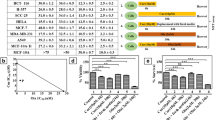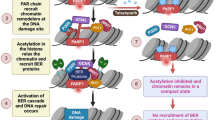Abstract
Purpose
Inhibition of Poly (ADP-ribose) Polymerases (PARP) results in the blocking of DNA repair cascades that eventually leads to apoptosis and cancer cell death. PARP inhibitors (PARPi) exhibit their actions either by inhibiting PARP-induced PARylation and/or by trapping PARP at the DNA damage site. But, the mechanism of PARPi-mediated induction of cellular toxicity via PARP-trapping is largely unknown.
Methods
The cellular toxicity of PARPi [Talazoparib (BMN) and/or Olaparib (Ola)] was investigated in oral cancer cells and the underlying mechanism was studied by using in vitro, in silico, and in vivo preclinical model systems.
Results
The experimental data suggested that induction of DNA damage is imperative for the optimal effectiveness of PARPi. Curcumin (Cur) exhibited maximum DNA damaging capacity in comparison to Resveratrol and 5-Flurouracil. Combination of BMN + Ola induced cell death in Cur pre-treated cells at much lower concentrations than their individual treatments. BMN + Ola treatment deregulated the BER cascade, potentiated PARP-trapping, caused cell cycle arrest and apoptosis in Cur pre-treated cells in a much more effective manner than their individual treatments. In silico data indicated the involvement of different amino acid residues which might play important roles in enhancing the BMN + Ola-mediated PARP-trapping. Moreover, in vivo mice xenograft data also suggested the BMN + Ola-mediated enhancement of apoptotic potentiality of Cur.
Conclusion
Thus, induction of DNA damage was found to be essential for optimal functioning of PARPi and BMN + Ola combination treatment enhanced the apoptotic potentiality of Cur in cancer cells by enhancing the PARP-trapping activity via modulation of BER cascade.






Similar content being viewed by others
Data availability
The datasets used and analyzed during the current study are available from the corresponding author upon reasonable request.
Code availability
Not applicable.
References
Chatterjee S, Kundu CN (2020) Nanoformulated quinacrine regulates NECTIN-4 domain specific functions in cervical cancer stem cells. Eur J Pharmacol 883:173308
Chatterjee S, Sinha S, Molla S et al (2021) PARP inhibitor Veliparib (ABT-888) enhances the anti-angiogenic potentiality of Curcumin through deregulation of NECTIN-4 in oral cancer: role of nitric oxide (NO). Cell Signal 80:109902
Das D, Preet R, Mohapatra P et al (2014) 5-Fluorouracil mediated anti-cancer activity in colon cancer cells is through the induction of Adenomatous Polyposis Coli: implication of the long-patch base excision repair pathway. DNA Repair 24:15–25
Dash SR, Chatterjee S, Sinha S et al (2022) NIR irradiation enhances the apoptotic potentiality of quinacrine-gold hybrid nanoparticles by modulation of HSP-70 in oral cancer stem cells. Nanomed Nanotechnol Biol Med 40:102502
Drean A, Lord CJ, Ashworth A (2016) PARP inhibitor combination therapy. Crit Rev Oncol Hematol 108:73–85
Gavande NS, VanderVere-Carozza PS, Hinshaw HD et al (2016) DNA repair targeted therapy: the past or future of cancer treatment? Pharmacol Ther 160:65–83
Javle M, Curtin NJ (2011) The role of PARP in DNA repair and its therapeutic exploitation. Br J Cancer 105:1114–1122
Kummar S, Chen A, Parchment RE et al (2012) Advances in using PARP inhibitors to treat cancer. BMC Med 10:1–5
Min A, Im S-A (2020) PARP inhibitors as therapeutics: beyond modulation of PARylation. Cancers 12:394
Mohapatra P, Satapathy SR, Das D et al (2014) Resveratrol mediated cell death in cigarette smoke transformed breast epithelial cells is through induction of p21Waf1/Cip1 and inhibition of long patch base excision repair pathway. Toxicol Appl Pharmacol 275:221–231
Molla S, Hembram KC, Chatterjee S et al (2020) PARP inhibitor olaparib enhances the apoptotic potentiality of curcumin by increasing the DNA damage in oral cancer cells through inhibition of BER cascade. Pathol Oncol Res 26:2091–2103
Molla S, Chatterjee S, Sethy C et al (2021) Olaparib enhances Curcumin-mediated apoptosis in oral cancer cells by inducing PARP trapping through modulation of BER and chromatin assembly. DNA Repair 105:103157
Murai J, Shar-yin NH, Das BB et al (2012) Trapping of PARP1 and PARP2 by clinical PARP inhibitors. Cancer Res 72:5588–5599
Murai J, Huang S-YN, Renaud A et al (2014a) Stereospecific PARP trapping by BMN 673 and comparison with olaparib and rucaparib. Mol Cancer Ther 13:433–443
Murai J, Zhang Y, Morris J et al (2014b) Rationale for poly (ADP-ribose) polymerase (PARP) inhibitors in combination therapy with camptothecins or temozolomide based on PARP trapping versus catalytic inhibition. J Pharmacol Exp Ther 349:408–416
Nayak D, Tripathi N, Kathuria D et al (2020) Quinacrine and curcumin synergistically increased the breast cancer stem cells death by inhibiting ABCG2 and modulating DNA damage repair pathway. Int J Biochem Cell Biol 119:105682
Park HJ, Bae JS, Kim KM et al (2018) The PARP inhibitor olaparib potentiates the effect of the DNA damaging agent doxorubicin in osteosarcoma. J Exp Clin Cancer Res 37:1–15
Patel AG, Sarkaria JN, Kaufmann SH (2011) Nonhomologous end joining drives poly (ADP-ribose) polymerase (PARP) inhibitor lethality in homologous recombination-deficient cells. Proc Natl Acad Sci 108:3406–3411
Pradhan R, Chatterjee S, Hembram KC et al (2021) Nano formulated Resveratrol inhibits metastasis and angiogenesis by reducing inflammatory cytokines in oral cancer cells by targeting tumor associated macrophages. J Nutr Biochem 92:108624
Redman RA, York SJ (2010) Mismatch repair proficiency as a predictor of response to the PARP inhibitor AZD2281. J Clin Oncol 28:e13644–e13644
Rouleau M, Patel A, Hendzel MJ et al (2010) PARP inhibition: PARP1 and beyond. Nat Rev Cancer 10:293–301
Siddharth S, Nayak D, Nayak A et al (2016) ABT-888 and quinacrine induced apoptosis in metastatic breast cancer stem cells by inhibiting base excision repair via adenomatous polyposis coli. DNA Repair 45:44–55
Sinha S, Molla S, Kundu CN (2021) PARP1-modulated chromatin remodeling is a new target for cancer treatment. Med Oncol 38:1–16
Trott O, Olson AJ (2010) AutoDock Vina: improving the speed and accuracy of docking with a new scoring function, efficient optimization, and multithreading. J Comput Chem 31:455–461
Yi T, Feng Y, Sundaram R et al (2019) Antitumor efficacy of PARP inhibitors in homologous recombination deficient carcinomas. Int J Cancer 145:1209–1220
Acknowledgements
We are very much thankful to the Indian Council of Medical Research (ICMR), the Government of India for providing a research fellowship to SC.
Funding
We are thankful to ICMR-BMS for providing funding to CNK to carry out the research.
Author information
Authors and Affiliations
Contributions
Conceptualization: SC and CNK; methodology: SC and AKD; formal analysis: SC; investigation: SC and CNK; resources: SC, AJD, SP, SS, BD and SRD; data curation: SC; writing—original draft preparation: SC; writing—review and editing: SC, AKD, SS and CNK; visualization: SC; supervision: CNK; project administration: CNK. All authors have read and agreed to the published version of the manuscript.
Corresponding author
Ethics declarations
Conflict of interest
All the authors declare that they have no potential conflict of interest.
Ethics approval
All the animal works and the experimental protocols were approved by the Institutional Animal Ethical Committee (IAEC, KIIT University, Bhubaneswar, India).
Additional information
Publisher's Note
Springer Nature remains neutral with regard to jurisdictional claims in published maps and institutional affiliations.
Supplementary Information
Below is the link to the electronic supplementary material.
Rights and permissions
Springer Nature or its licensor holds exclusive rights to this article under a publishing agreement with the author(s) or other rightsholder(s); author self-archiving of the accepted manuscript version of this article is solely governed by the terms of such publishing agreement and applicable law.
About this article
Cite this article
Chatterjee, S., Dhal, A.K., Paul, S. et al. Combination of talazoparib and olaparib enhanced the curcumin-mediated apoptosis in oral cancer cells by PARP-1 trapping. J Cancer Res Clin Oncol 148, 3521–3535 (2022). https://doi.org/10.1007/s00432-022-04269-7
Received:
Accepted:
Published:
Issue Date:
DOI: https://doi.org/10.1007/s00432-022-04269-7




